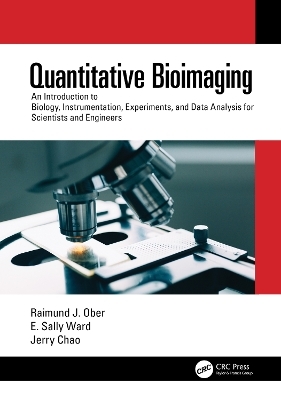
Quantitative Bioimaging
An Introduction to Biology, Instrumentation, Experiments, and Data Analysis for Scientists and Engineers
Seiten
2020
CRC Press (Verlag)
978-1-138-59898-0 (ISBN)
CRC Press (Verlag)
978-1-138-59898-0 (ISBN)
This textbook provides a truly unique introduction that integrates the concepts and methods of optics, molecular and cellular biology, image analysis, and bioengineering. The coverage spans from essential aspects of molecular and cellular biology to a detailed treatment of practical aspects.
Quantitative bioimaging is a broad interdisciplinary field that exploits tools from biology, chemistry, optics, and statistical data analysis for the design and implementation of investigations of biological processes. Instead of adopting the traditional approach of focusing on just one of the component disciplines, this textbook provides a unique introduction to quantitative bioimaging that presents all of the disciplines in an integrated manner. The wide range of topics covered include basic concepts in molecular and cellular biology, relevant aspects of antibody technology, instrumentation and experimental design in fluorescence microscopy, introductory geometrical optics and diffraction theory, and parameter estimation and information theory for the analysis of stochastic data.
Key Features include:
Comprises four parts, the first of which provides an overview of the topics that are developed from fundamental principles to more advanced levels in the other parts.
Presents in the second part an in-depth introduction to the relevant background in molecular and cellular biology and in physical chemistry, which should be particularly useful for students without a formal background in these subjects.
Provides in the third part a detailed treatment of microscopy techniques and optics, again starting from basic principles.
Introduces in the fourth part modern statistical approaches to the determination of parameters of interest from microscopy data, in particular data generated by single molecule microscopy experiments.
Uses two topics related to protein trafficking (transferrin trafficking and FcRn-mediated antibody trafficking) throughout the text to motivate and illustrate microscopy techniques.
An online appendix providing the background and derivations for various mathematical results presented or used in the text is available at http://www.routledge.com/9781138598980.
Quantitative bioimaging is a broad interdisciplinary field that exploits tools from biology, chemistry, optics, and statistical data analysis for the design and implementation of investigations of biological processes. Instead of adopting the traditional approach of focusing on just one of the component disciplines, this textbook provides a unique introduction to quantitative bioimaging that presents all of the disciplines in an integrated manner. The wide range of topics covered include basic concepts in molecular and cellular biology, relevant aspects of antibody technology, instrumentation and experimental design in fluorescence microscopy, introductory geometrical optics and diffraction theory, and parameter estimation and information theory for the analysis of stochastic data.
Key Features include:
Comprises four parts, the first of which provides an overview of the topics that are developed from fundamental principles to more advanced levels in the other parts.
Presents in the second part an in-depth introduction to the relevant background in molecular and cellular biology and in physical chemistry, which should be particularly useful for students without a formal background in these subjects.
Provides in the third part a detailed treatment of microscopy techniques and optics, again starting from basic principles.
Introduces in the fourth part modern statistical approaches to the determination of parameters of interest from microscopy data, in particular data generated by single molecule microscopy experiments.
Uses two topics related to protein trafficking (transferrin trafficking and FcRn-mediated antibody trafficking) throughout the text to motivate and illustrate microscopy techniques.
An online appendix providing the background and derivations for various mathematical results presented or used in the text is available at http://www.routledge.com/9781138598980.
Raimund J. Ober, E. Sally Ward, Jerry Chao
1. Introduction, Then and Now 2. Introduction to Two Problems in Cellular Biology 3. Basics of Microscopy Techniques 4. Introduction to Image Formation and Analysis 5. From genes to proteins 6. Antibodies 7. Cloning of genes for protein expression 8. Principles of Fluorescence 9. Cells 10. Microscope Designs 11. Microscopy Experiments 12. Detectors 13. Geometrical Optics 14. Diffraction 15. From Photons to Image: Data Models 16. Parameter Estimation 17. Fisher Information and Cramér–Rao Lower Bound 18. Localizing Objects and Single Molecules in Two Dimensions 19. Localizing Objects and Single Molecules in Three Dimensions 20. Resolution 21. Deconvolution 22. Spatial Statistics. Online Appendices.
| Erscheinungsdatum | 15.01.2020 |
|---|---|
| Zusatzinfo | 1 Tables, black and white; 234 Illustrations, color |
| Verlagsort | London |
| Sprache | englisch |
| Maße | 178 x 254 mm |
| Gewicht | 1360 g |
| Themenwelt | Medizin / Pharmazie ► Physiotherapie / Ergotherapie ► Orthopädie |
| Naturwissenschaften ► Physik / Astronomie ► Optik | |
| Technik ► Elektrotechnik / Energietechnik | |
| Technik ► Medizintechnik | |
| Technik ► Umwelttechnik / Biotechnologie | |
| ISBN-10 | 1-138-59898-4 / 1138598984 |
| ISBN-13 | 978-1-138-59898-0 / 9781138598980 |
| Zustand | Neuware |
| Haben Sie eine Frage zum Produkt? |
Mehr entdecken
aus dem Bereich
aus dem Bereich
Spiraldynamik - programmierte Therapie für konkrete Resultate
Buch | Hardcover (2021)
Thieme (Verlag)
CHF 146,95


